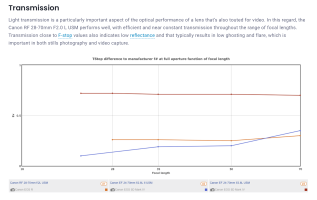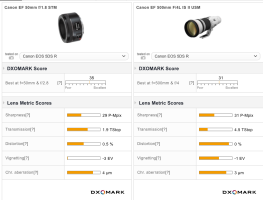I should start by saying if this has been discussed here elsewhere please send me to the thread, but an initial search didn't throw anything up. My question is really, is anyone aware of any broad standardised test of T Stops across lenses? It's not meant to be an idle question, I've been to the DxO site which gives the scores for quite a few lenses (although not obviously mapped to EV unless it's a 1:1 mapping?). I'll attach a screen grab which shows (I think) that the Canon EF 24-70mm f2.8L ii USM and the Canon EF 24-70mm f2.8L USM seem to have 1/2EV of different amounts of light hitting the sensor (which seems like quite a lot). In other words (I think) one is letting in 1/2 a stop of light "more" to the sensor even though they have the same (and constant) F2.8 aperture. (DxO have also helpfully attached the same camera to both lenses). The second question relates to any real world experiences people may have had. For any given aperture primes are supposed to be better for light transmission than zooms for any given F Stop (less glass), and I've noted how long zooms seem to struggle with low light more than they "should" given their stated aperture. 




